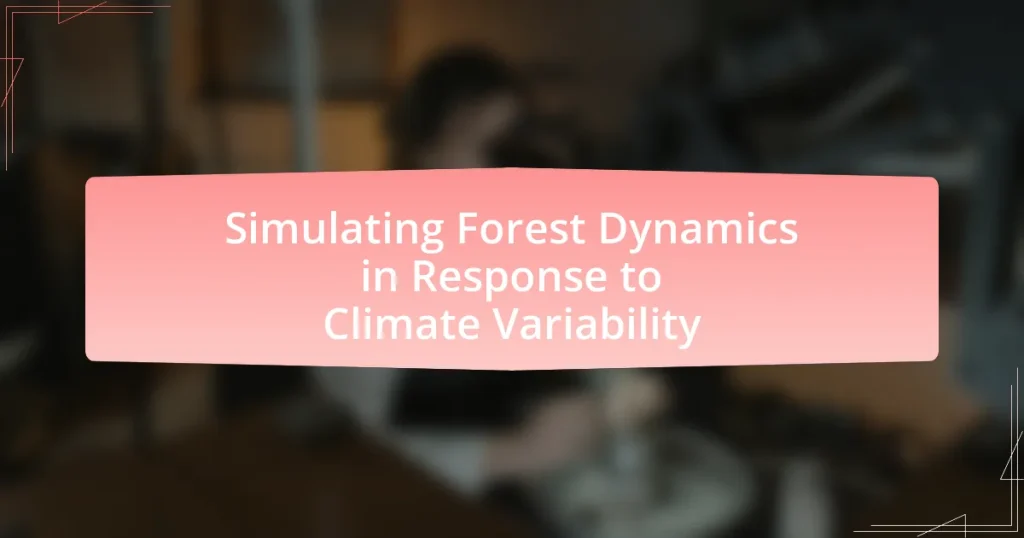Simulating forest dynamics in response to climate variability involves modeling the changes in forests over time due to fluctuations in climate factors such as temperature and precipitation. This article explores how these simulations can predict shifts in species composition, growth rates, and ecosystem functions, highlighting the importance of understanding these dynamics for effective forest management and conservation strategies. Key factors influencing forest dynamics, including climate change, soil composition, and disturbances, are examined, along with the methods used in simulations, such as process-based and statistical models. The implications of simulation results for policy decisions and sustainable forest management practices are also discussed, alongside the challenges and best practices in the field.

What is Simulating Forest Dynamics in Response to Climate Variability?
Simulating forest dynamics in response to climate variability involves modeling how forests change over time due to fluctuations in climate conditions. This simulation incorporates factors such as temperature, precipitation, and extreme weather events to predict shifts in species composition, growth rates, and ecosystem functions. Research indicates that these simulations can help in understanding potential impacts on biodiversity and forest health, as evidenced by studies like “Climate Change and Forest Dynamics” published in the journal Forest Ecology and Management, which highlights the importance of predictive modeling in forest management strategies.
How do forest dynamics interact with climate variability?
Forest dynamics interact with climate variability through changes in species composition, growth rates, and mortality patterns. Variability in temperature and precipitation affects tree growth and regeneration, leading to shifts in forest structure and function. For instance, increased temperatures can enhance growth in some species while causing stress in others, resulting in altered competitive dynamics. Additionally, extreme weather events, such as droughts or storms, can lead to increased tree mortality, further influencing forest composition. Studies have shown that forests are adapting to climate variability, with species migrating to more suitable habitats, which can be observed in regions like the eastern United States, where tree species have shifted northward in response to warming temperatures.
What are the key factors influencing forest dynamics?
Key factors influencing forest dynamics include climate change, soil composition, species interactions, and disturbances such as fire and pests. Climate change affects temperature and precipitation patterns, which in turn influence tree growth and species distribution. Soil composition determines nutrient availability and water retention, impacting forest health and productivity. Species interactions, including competition and predation, shape community structure and biodiversity. Disturbances like wildfires and pest outbreaks can drastically alter forest composition and regeneration patterns. These factors collectively drive the complex processes of forest dynamics, as evidenced by studies showing shifts in species distribution in response to changing climate conditions.
How does climate variability impact these factors?
Climate variability significantly impacts forest dynamics by altering species composition, growth rates, and ecosystem resilience. Changes in temperature and precipitation patterns can lead to shifts in tree species distribution, as certain species may thrive while others decline. For instance, a study published in “Global Change Biology” by Allen et al. (2010) indicates that increased temperatures can enhance the growth of some tree species while simultaneously increasing stress on others, leading to a potential loss of biodiversity. Additionally, climate variability can affect the frequency and intensity of disturbances such as droughts and wildfires, further influencing forest structure and function. This interplay between climate variability and forest dynamics underscores the importance of understanding these factors for effective forest management and conservation strategies.
Why is simulating forest dynamics important?
Simulating forest dynamics is important because it enables researchers and policymakers to understand how forests respond to environmental changes, particularly climate variability. This understanding is crucial for effective forest management and conservation strategies, as it helps predict shifts in species composition, growth rates, and ecosystem services. For instance, studies have shown that climate change can alter tree growth patterns and increase the frequency of disturbances like wildfires, which can significantly impact forest health and biodiversity. By simulating these dynamics, stakeholders can make informed decisions to mitigate negative impacts and enhance forest resilience.
What insights can simulations provide for forest management?
Simulations can provide critical insights for forest management by modeling the impacts of climate variability on forest dynamics. These simulations allow forest managers to predict changes in species composition, growth rates, and ecosystem services under various climate scenarios. For instance, studies have shown that simulations can reveal how increased temperatures and altered precipitation patterns may affect tree mortality rates and regeneration processes, enabling proactive management strategies. Additionally, simulations can assess the effectiveness of different management practices, such as thinning or prescribed burns, in enhancing forest resilience to climate stressors. This data-driven approach supports informed decision-making, ultimately leading to more sustainable forest management practices.
How do simulations help in understanding ecological responses?
Simulations help in understanding ecological responses by providing a controlled environment to model complex interactions within ecosystems. These models allow researchers to predict how various factors, such as climate change, species interactions, and disturbances, influence ecological dynamics over time. For instance, studies using simulation models like LANDIS-II have demonstrated how forest composition and structure can shift in response to changing temperature and precipitation patterns, revealing potential future scenarios for biodiversity and ecosystem services. Such simulations are essential for informing conservation strategies and resource management by illustrating potential outcomes based on different management decisions and environmental changes.

What methods are used in simulating forest dynamics?
Methods used in simulating forest dynamics include process-based models, statistical models, and agent-based models. Process-based models, such as the Forest Vegetation Simulator, simulate growth and competition among trees based on physiological processes and environmental factors. Statistical models, like regression analysis, utilize historical data to predict future forest conditions and dynamics. Agent-based models simulate individual tree behaviors and interactions within a forest ecosystem, allowing for the exploration of complex dynamics. These methods are validated through empirical data and case studies, demonstrating their effectiveness in understanding forest responses to climate variability.
How do different modeling approaches compare?
Different modeling approaches for simulating forest dynamics in response to climate variability vary in complexity, accuracy, and applicability. For instance, process-based models, such as the Forest-BGC model, simulate physiological processes and provide detailed insights into tree growth and carbon cycling, making them highly accurate but computationally intensive. In contrast, empirical models, like the Forest Inventory and Analysis (FIA) data-driven models, rely on observed data to predict forest dynamics, offering faster results but potentially less precision in complex scenarios. Studies have shown that while process-based models can capture intricate interactions within ecosystems, empirical models are often preferred for large-scale assessments due to their efficiency and ease of use. This comparison highlights the trade-offs between accuracy and computational demands in forest modeling approaches.
What are the strengths and weaknesses of each modeling approach?
The strengths and weaknesses of modeling approaches in simulating forest dynamics in response to climate variability vary significantly. Process-based models excel in capturing complex ecological interactions and provide detailed insights into physiological processes, but they often require extensive data and can be computationally intensive. Statistical models, on the other hand, are generally easier to implement and can handle large datasets effectively, yet they may oversimplify ecological relationships and lack mechanistic understanding. Hybrid models combine the strengths of both approaches, offering a balance between detail and data efficiency, but they can be complex to develop and validate. Each modeling approach thus presents unique advantages and limitations that influence their applicability in forest dynamics research.
How do these models incorporate climate data?
Models simulating forest dynamics incorporate climate data by integrating variables such as temperature, precipitation, and atmospheric CO2 levels to predict tree growth, species distribution, and ecosystem responses. These models utilize historical climate records and future climate projections to assess how changing conditions affect forest health and biodiversity. For instance, studies have shown that incorporating climate data allows for more accurate predictions of forest productivity and resilience, as evidenced by research published in “Global Change Biology” by Allen et al., which highlights the correlation between climate variables and forest dynamics.
What role do data and technology play in simulations?
Data and technology are essential in simulations as they provide the foundational inputs and computational power necessary for accurate modeling. In the context of simulating forest dynamics in response to climate variability, data such as historical climate records, soil composition, and species distribution inform the parameters of the simulation models. Technology, including advanced algorithms and high-performance computing, enables the processing of large datasets and the execution of complex simulations that predict forest responses to changing climatic conditions. For instance, the use of remote sensing technology allows for real-time monitoring of forest health and growth patterns, enhancing the accuracy of simulations.
What types of data are essential for accurate simulations?
Accurate simulations of forest dynamics in response to climate variability require several essential types of data. These include climate data, such as temperature and precipitation patterns, which influence forest growth and health. Additionally, ecological data, including species distribution, soil composition, and biodiversity metrics, are crucial for understanding interactions within forest ecosystems. Historical data on forest cover changes and disturbances, such as wildfires or pest outbreaks, also provide context for modeling future scenarios. Furthermore, remote sensing data enhances the accuracy of simulations by offering real-time insights into forest conditions and changes. Collectively, these data types enable robust modeling of forest responses to climate variability, ensuring predictions are grounded in empirical evidence.
How has technology advanced the field of forest dynamics simulation?
Technology has significantly advanced the field of forest dynamics simulation by integrating high-resolution remote sensing data, sophisticated modeling software, and machine learning algorithms. These advancements enable researchers to create more accurate and dynamic models that simulate forest growth, species interactions, and responses to climate variability. For instance, the use of LiDAR technology allows for detailed three-dimensional mapping of forest structures, which enhances the precision of simulations. Additionally, machine learning techniques can analyze vast datasets to identify patterns and predict future forest dynamics under various climate scenarios, as demonstrated in studies like “A Machine Learning Approach to Predict Forest Dynamics” published in the journal Forest Ecology and Management. These technological innovations collectively improve the understanding of forest ecosystems and their resilience to climate change.

What are the implications of simulation results?
Simulation results in the context of forest dynamics and climate variability indicate potential changes in species distribution, forest composition, and ecosystem services. These results suggest that as climate conditions shift, certain tree species may thrive while others decline, leading to altered biodiversity and habitat availability. For instance, studies have shown that increased temperatures and altered precipitation patterns can significantly affect growth rates and survival of various tree species, which in turn impacts carbon sequestration and forest resilience. Therefore, understanding these implications is crucial for effective forest management and conservation strategies in the face of climate change.
How can simulation outcomes inform policy decisions?
Simulation outcomes can inform policy decisions by providing data-driven insights into potential environmental impacts and management strategies. For instance, simulations of forest dynamics under varying climate scenarios can reveal how different policies may affect biodiversity, carbon sequestration, and ecosystem resilience. Research conducted by the U.S. Forest Service indicates that simulations can predict shifts in species distribution and forest composition, allowing policymakers to develop adaptive management strategies that mitigate negative impacts of climate change. By integrating these outcomes into decision-making processes, policymakers can create more effective and sustainable environmental policies.
What are the potential impacts on conservation strategies?
The potential impacts on conservation strategies include altered species distributions, changes in ecosystem services, and increased vulnerability of habitats. Climate variability can lead to shifts in forest dynamics, affecting the composition and health of ecosystems. For instance, studies have shown that rising temperatures and changing precipitation patterns can result in the migration of tree species to higher elevations or latitudes, which may disrupt existing conservation plans that are based on historical species ranges. Additionally, altered forest dynamics can impact carbon storage and water regulation, essential services provided by forests, thereby necessitating adaptive management strategies to ensure the effectiveness of conservation efforts.
How can simulations guide sustainable forest management practices?
Simulations can guide sustainable forest management practices by providing predictive models that analyze the impact of various management strategies on forest dynamics under changing climate conditions. These models allow forest managers to visualize potential outcomes of different interventions, such as selective logging or reforestation, and assess their long-term effects on biodiversity, carbon sequestration, and ecosystem health. For instance, research published in “Forest Ecology and Management” demonstrates that simulations can predict shifts in species composition and forest structure due to climate variability, enabling managers to make informed decisions that enhance resilience and sustainability.
What challenges exist in simulating forest dynamics?
Simulating forest dynamics faces several challenges, primarily due to the complexity of ecological interactions and the variability of climate factors. The intricate relationships among species, their responses to environmental changes, and the influence of disturbances such as fires or pests complicate accurate modeling. Additionally, data scarcity, particularly in remote or less-studied regions, limits the ability to create comprehensive models. For instance, a study published in “Ecological Modelling” by Bugmann (2001) highlights that uncertainties in parameter estimation and the need for high-resolution data further hinder effective simulations. These challenges necessitate advanced modeling techniques and interdisciplinary approaches to improve the accuracy of forest dynamics simulations in the context of climate variability.
What are the limitations of current simulation models?
Current simulation models for forest dynamics in response to climate variability have several limitations, including oversimplification of ecological processes, inadequate representation of species interactions, and reliance on uncertain climate projections. These models often fail to capture the complexity of forest ecosystems, which can lead to inaccurate predictions of forest responses to climate change. For instance, many models do not account for the effects of disturbances such as pests, diseases, and extreme weather events, which can significantly alter forest dynamics. Additionally, the parameterization of these models is often based on limited empirical data, resulting in uncertainties in model outputs. Studies have shown that models like the LANDIS-II framework struggle with accurately simulating species migration and competition under changing climate scenarios, highlighting the need for improved model calibration and validation.
How can researchers address these challenges moving forward?
Researchers can address challenges in simulating forest dynamics in response to climate variability by integrating advanced modeling techniques and interdisciplinary collaboration. Utilizing machine learning algorithms can enhance predictive accuracy by analyzing large datasets on climate patterns and forest responses. For instance, studies have shown that incorporating remote sensing data improves the understanding of forest health and growth rates under varying climate conditions. Additionally, fostering partnerships between ecologists, climatologists, and data scientists can lead to more comprehensive models that account for complex interactions within forest ecosystems. This collaborative approach is supported by findings from the Global Forest Observations Initiative, which emphasizes the importance of shared data and methodologies in improving forest management strategies.
What best practices should be followed in simulating forest dynamics?
Best practices in simulating forest dynamics include using high-resolution spatial data, incorporating ecological processes, and validating models with empirical data. High-resolution spatial data allows for accurate representation of forest structure and composition, which is crucial for understanding dynamics. Incorporating ecological processes, such as species interactions and nutrient cycling, ensures that models reflect real-world complexities. Validating models with empirical data, such as historical growth rates and climate records, enhances the reliability of simulations and helps in adjusting parameters for better accuracy. These practices are supported by studies like “Modeling Forest Dynamics: A Review” by Bugmann and Fischer, which emphasize the importance of data quality and ecological realism in forest simulations.


